User experience, Product management
Customer Journey Map
A visual representation of the steps a customer takes when interacting with a company, from initial contact to purchase and beyond.
Also called: Customer Journey, Customer Experience Map, User Journey Map, User Experience Map, and Customer Journey Diagram
See also: Service Blueprint
Relevant metrics: Customer Satisfaction, Conversion Rate, Activation Rate, Customer Retention Rate, Average Order Value, and Net Promoter Score
What is a Customer Journey Map?
A Customer Journey Map is a visual representation of the steps a customer takes when interacting with a product or service. It is a tool used to understand the customer experience from the customer’s perspective. It is typically composed of a timeline that outlines the customer’s journey, from initial contact with the product or service to the end of the customer’s experience. The timeline is accompanied by a visual representation of the customer’s emotions and thoughts throughout the journey. The map also includes the customer’s interactions with the product or service, such as the channels used, the touchpoints experienced, and the customer’s feedback.
Where did Customer Journey Map originate from?
The concept of customer journey mapping has evolved over time, but it has its roots in the field of service design, which emerged in the 1980s and 1990s. Service design is a user-centered design approach that aims to create better service experiences for customers by understanding their needs and designing services that meet those needs.
In 1998, OxfordSM (then known as Oxford Corporate Consultants) introduced the customer journey mapping approach as a means of supporting Eurostar in establishing and implementing their corporate mission and brand proposition in service design. OxfordSM later applied this approach to a variety of contexts, including the UK Government, which publicly published guidance on the technique. Today, customer journey mapping is one of the most commonly used tools in service design, as it allows organizations to visualize intangible services and improve their customer experience.
The use of customer journey mapping has become increasingly popular in recent years, as organizations have recognized the importance of creating positive customer experiences as a key factor in their success. Today, customer journey mapping is a widely-used tool for understanding and improving the customer experience, and it continues to evolve as new technologies and customer expectations emerge.
The components of a Customer Journey Map
A Customer Journey Map visually or graphically lays out the relationship a user has with an organization, service, product, brand as a story over time and across channels.
It acts as a container that binds multiple user research deliverables together and across channels to form an overall story over time. Typical user research activities include personas, scenarios, empathy maps, and affinity maps.
Depending on the nuances of the customer’s journey, the map can be heavy on either iconography and other visual and graphical elements or more narrative and text-based elements.
The story is told from the customer’s perspective, but also emphasizes important and critical intersections between customer expectations and business requirements.
As a minimum, Customer Journey Maps should include:
- A timeline. As a minimum, your map should explain in what context your product is relevant for your customers before, during, and after his or her interaction. More elaborate versions visualize how customers jump in and out of the product experience.
- Channels. Through what channel will customers interact. Where does the interaction take place and in what context (website, native app, call-center, in-store).
- Touchpoints. What are customer actions and interactions with your product experience? Touchpoints explain what the customer is doing. Are touchpoints guaranteed (you own the moment on your platform) or possible (for instance through ads).
- Persona. The archetypical user who is interacting with your product experience. As a minimum a stereotypical label is needed, but better is an actual accompanying persona description full of user needs, goals, thoughts, feelings, opinions, expectations, and pain points.
Depending on what message you wish to communicate, Customer Journey Maps can also map:
- User goals. What user goals do customers have before, during, and after they interact with your organization or product experience. Be aware that users might not have any specific goals all throughout their journey, but that it is your job to map out how you introduce a goal for them to embrace.
- Business goals. What business goals are fulfilled upon successful interaction. In some interactions, the business goals might be to keep the user engaged so a more direct business goal can be fulfilled upon later interaction. Consider illustrating how business goals align with user goals.
- KPIs. The Key Performance Indicators and metrics that can help determine whether a customer interaction was successful or not.
- Emotions. What emotions do customers feel going in to an interaction, during an interaction and after an interaction. Is it positive or negative? Do users feel anxiety or are they bored? Are they clear or unclear about their coming decision?
- Moments of truth. Positive interactions that leave a lasting impression. You might consider planning moments of truths for touchpoints known to generate friction (feelings of frustration or anxiety.
- Moments to intervene. What are the most opportune moments to intervene in a customer’s experience in order to change habits, behavior, push a sale, or influence any other behavior.
- Quotes. A quote from an actual user experiencing an actual frustration can be extremely powerful in coining and highlighting frustrations or other challenges when mapped to specific touchpoints.
- User considerations. What choices are to be made and considered and what goes through the mind of the user in the specific moment.
- User actions. What kind of action are users performing? Is it intensive or relaxed?
- Supporting characters. What other archetypical users, or personas, contribute to the experience - from your own organization or friends, colleagues, or caregivers of the users.
- Responsible organization. What part of your organization is responsible for handling each user interaction?
- Organizational activities. What are the corresponding internal organizational activities to user actions – the internal work to be done that a user interaction triggers.
How to create a Customer Journey Map
Start by reviewing the business goals of your organization and what goals you have for your customer journey mapping initiative. Having your goals set straight from the start will help you align focus and create a Customer Journey Map that gets the message you want to convey clearly.
The next step is to gather the research you have and map what research you still need to collect in order to successfully communicate your intended message backed by empirical evidence - qualitative or quantitative. With an overview of relevant research in hand, it’s relatively easy to map out existing and future touchpoints and channels.
Now, revisit your goals and decide on what specific perspectives of the customer’s journey it makes sense to focus on in your journey map. If the customer is undergoing an emotional rollercoaster along the journey, it might be relevant to visualize how emotions change. Similarly, if the complexity of customer decisions change over time, it might be relevant to visualize it as it might indicate points in time, where users are likely to abandon your experience.
There is no one way to sketch the customer journey, but what you want to aim for is a representation that best represents the message you want across. So be creative and aim to focus on empathizing with the user and how the future journey differs from the current one.
Common design choices
A Customer Journey Map comes in many shapes and sizes. Here are some of the design choices you might have to make:
- The entire story or just a scenario. Do you want to focus on a specific part of a business interaction (for instance “cancel my subscription” or “sign up”) better or illustrate how it interplays with the entire customer journey.
- Stage perspective. From what perspective have you sliced the customer journey? Is it from the perspective of the business or the user? Is the described journey focused on a specific conversion goal or does it take off-brand contact into consideration as well?
- Multiple segments. Does it make sense to illustrate how different customer segments differ in attitude, action, and thinking? Consider including multiple personas to illustrate segments and color-code their interactions or divide them in different swim lanes.
Step by step guide to creating a Customer Journey Map
- Review business goals. Map your organization’s business goals at large and what goals you want to achieve by creating a Customer Journey Map
- Gather research. Review relevant qualitative and quantitative user research that provide insights into the customer experience. If you haven’t gathered a sufficient amount of user research to create a Customer Journey Map of high enough quality, create tasks to get those research activities finished.
- Map existing and future touchpoints and channels. Based on the gathered research, extract a list of all customer touchpoints and through what channels those touchpoints are reached today. Then brainstorm what touchpoints and channels a future customer journey might include.
- Brainstorm with appropriate lenses. Depending on what you wish to communicate and what “lenses” showcase this the best, brainstorm from different perspectives. You might consider combining an Empathy Map to communicate a deeper understanding of a customer experience and the intrinsic needs of users or map what moments in a customer journey that represent both opportune moments of change for your users and your business.
- Sketch the journey. Your goal is to emphasize, highlight, and elaborate critical intersections between customer expectations and business requirements. Customer Journey Maps come in many shapes and sizes. The form that best fits the message you want across is better for you to decide.
- Refine and validate. Your job is not done having sketched the first version. Now it’s time to show it to user researchers, product owners, and validate it with real users. Iterate until you do not receive any significant new input. You might also want to consider refining and maintaining journey maps over time – set a calendar event 6 months from now to evaluate how your current customer experience matches your visioned journey.
How can Customer Journey Maps help you?
A Customer Journey map goes beyond what is visible to the company and accounts for the entire customer journey, including the ones that are visible from the perspective of the product. The aim is to create a deeper insight into the customer to help businesses understand them better than ever before.
The objective of customer journey mapping is to gain a comprehensive understanding of the customer experience and enhance its quality by ensuring consistency and a seamless experience at all touchpoints and channels. In order to map the customer’s journey, you need to again an understanding of it first through interviews, observations, feedback, quantitative analytivs, and whatever data you can create or get hold of. Once you have a solid understanding of customer journeys within your business, you can effectively improve the customer experience, leading to numerous benefits.
Both through the process of mapping out the cusomter’s experience and after having mapped it out, you will gain several benefits.
You will gain a holistic overview, while also being able to zoom in
A bird’s eye view of the entire customer journey provides a holistic perspective, allowing teams to identify core customer journey paths, recognize where development will have the greatest impact, and resolve specific customer hurdles. By identifying what parts of the journey that negatively influence the customer experience or key decision points and steps, product teams can build with more accuracy to customer’s needs, increase conversion rates, and retention rates.
Zoom in on a single journey
At the same time, Customer Journey Mapps can also help businesses zoom in on a single customer journey or funenl in a specific channel, leading to an understanding of the necessary metrics for identifying customer progress and fall-out points, providing opportunities to bring customers back on board. This process can further allow businesses to prioritize their customer experience strategy and reveal the gaps between various channels and departments.
Walk in your customer’s shoes
Gathering real-world insights enables businesses to delve deeper into the customers’ interactions with their brand, ultimately fostering a greater understanding of the customer experience. A strong customer journey mapping process enables businesses to challenge their assumptions, revealing that customers don’t always act or think as expected.
By identifying where users struggle, get frustrated, or drop off, businesses can prioritize website and product improvements that provide a smoother experience, such as altering the position of CTAs or adapting the navigation architecture to make important information easily accessible.
By cultivating a culture of placing oneself in the customers’ shoes, all stakeholders can view the brand from both the customer perspective (outside-in) and the business perspective (inside-out).
By cultivating a culture of placing oneself in the customers’ shoes, all stakeholders can view the brand from both the customer perspective (outside-in) and the business perspective (inside-out). The process of creating a customer journey map allows for the observation of sales experiences from the customer’s viewpoint rather than the sales perspective, leading to a greater understanding of their point of view and why they chose your product over another.
Identify unmet user needs
A strong understanding of customer needs across different interactions enables businesses to identify gaps in the journey and offer additional touchpoints or improve existing ones. This approach eliminates guesswork by mapping out how customers navigate websites or apps, allowing businesses to pinpoint blockers, identify areas where customers are trying to engage but can’t, or identify areas where completing an action takes too much effort.
Increasing awareness of customer needs can minimize frustrations by providing the right information and features at specific stages for a better user experience. For example, if a customer struggles with onboarding touchpoints, delivering an explanatory video or pop-up tooltip at the right time can enhance the user experience. Alternatively, if they become caught in an endless help-page loop, updating website pages to provide the most relevant information at key points can make a significant difference.
Identify how your brand engages customers
Mapping out the customer journey offers businesses the chance to see how their brand first engages a potential customer and then moves through the touchpoints of the entire sales process. It helps businesses to assess insights, impact, issues/opportunities, and innovation. It enables businesses to optimize budgets and effort for changes they want to make to the customer experience. The moments that matter - where there is the greatest emotional load - are identified, and businesses can ensure that these moments match their customers’ expectations of their products, brand, and service teams.
Customer journey maps alone may not be enough to give you a comprehensive view of your brand engagement. Here are some other methods you can use in combination with customer journey maps to find gaps in how your brand engages with your customers and your brand promise and values.
Combining Brand Audits with Customer Journey Mapping
A brand audit is an analysis of your brand’s strengths and weaknesses, both internally and externally. It helps you understand how your brand is perceived in the market, whether it is consistent across all touchpoints, and how well it aligns with your brand promise and values. By conducting a brand audit, you can identify areas where your brand may be falling short and find ways to address them.
You can combine customer journey maps with a brand audit by using the maps as a starting point for analyzing each touchpoint in the customer journey. As you go through each touchpoint, evaluate whether it aligns with your brand promise and values. Look for areas where your brand messaging may be inconsistent or unclear, and identify opportunities to strengthen your brand engagement.
Creating memorable experiences
Businesses want to create memorable first impressions and deliver differentiated buying experiences to their customers. They want to find out how their customers shop in today’s digital world, the most influential channels and touchpoints in their customer journey, and how they can impact these. Customer journey mapping is a powerful technique for understanding what motivates customers - what their needs are, their hesitations, and concerns.
Visualizing Customer Emotions
Customer journeys are not only about actions, but also about emotions. It is difficult to turn feelings into concrete data and even harder to imagine how customers will actually feel when using a product or visiting a website. However, understanding customer emotions is key to providing a better service and building brand trust.
A well-researched customer journey map can help businesses visualize what customers are thinking, feeling, and doing at each stage. By gathering insights on customer emotions and acting on them, businesses can create personalized experiences that make customers feel understood and valued. This helps to foster a deeper connection between customers and the brand, promoting loyalty and advocacy.
People are more likely to remember experiences that evoke strong emotions.
People are more likely to remember experiences that evoke strong emotions. By designing experiences that evoke positive emotions such as joy, surprise, or delight, businesses can create memories that last.
Identify pain points
Customer journey mapping can help businesses identify pain points that customers experience throughout their journey. By addressing these pain points, businesses can create a more seamless and enjoyable experience for their customers. By understanding the needs of customers at each touchpoint, businesses can create experiences that are personalized and relevant. This can help create a strong emotional connection between the customer and the brand, leading to a memorable experience.
Empathy Mapping and Value Proposition Mapping are techniques that helps businesses understand the feelings and motivations of their customers. This can help businesses create experiences that are more empathetic and meaningful. By identifying pain points and designing for their associated emotions, businesses can create experiences that leave a lasting positive impression.
Rally and align your organization
Creating customer journey maps is not just about producing a visual representation of the steps a customer takes when interacting with a brand, but also about the collaborative process of creating the map itself. This process can be immensely helpful in aligning an organization on priorities and objectives, as teams across departments gain a shared understanding and learn about the customer together.
Mapping the customer journey requires a collaborative effort among different teams, including UX, marketing, product, sales, customer service and success, shipping, management, and others. These teams can offer diverse perspectives and insights on how they interact with customers, helping to solve customer journey issues more efficiently and effectively. This process allows for cross-functional collaboration, as each department can share their unique insights into the customer journey and work together to identify gaps and pain points in the experience.
By aligning cross-functional stakeholders, businesses can reduce politics and guesswork around customer needs and clarify areas of ownership, accountability, and points of hand-off between teams. This promotes a smoother and more coherent interaction with the brand, ensuring that customers receive a consistent and personalized experience throughout their journey.
This collaboration also helps to break down silos within an organization, as teams work towards a common goal of creating a seamless customer experience. By understanding the customer journey as a whole, teams can gain a better appreciation for the impact their work has on the customer experience and how their efforts can be aligned to improve it.
The collaborative process of creating a customer journey map fosters a shared understanding of the customer across the organization. As teams work together to create the map, they learn about the customer’s needs, motivations, and behaviors at each stage of the journey. This shared understanding helps to align teams around the customer, rather than around specific departmental goals or objectives.
Use customer journeys to tell the customer’s story
Although most organizations are reasonably good at gathering data about their customers, data alone fails to communicate the frustrations and experiences the customer experienced. A story can do that, and one of the best storytelling tools in business is the customer journey map. It uses storytelling and visuals to illustrate the relationship a customer has with a business over a period of time. The story is being told from the perspective of the customer, which provides insight into the total experience of the customer.
Customer journey maps can help organizations create a consistent narrative that aligns with the customer’s journey. By identifying the touchpoints and interactions that customers have with the organization, the organization can create a coherent story that reflects the customer’s experience.
This in turn helps companies foster empathy towards the customer. By visualizing the customer’s journey, employees can better understand the emotions and needs of the customer, which can aid in creating more emotionally resonant stories.
When Customer Journey maps are failing you
Journey mapping is not an easy task, and it requires considering all aspects of human experience. Customer journey maps can be a powerful tool for organizations to understand and improve the customer experience. However, they can also fail businesses in several ways. Organizations need to put in a lot of effort to create a memorable customer experience, one that considers the emotional and subconscious aspects of human experience, starts from the right point, accounts for unique customer journeys, reflects evolving customer behavior and values, and identifies and addresses obstacles. By doing so, organizations can create a customer-centric culture and differentiate themselves from their competitors.
However, that is easier said than done and journey maps are not a silver bullet – and they can sometimes fail businesses in several ways. Let’s explore typical pitfalls and provide insights into how organizations can avoid them.
The Rational Bias in Customer Journey Mapping
Most journey mapping focuses on the rational side of the customer experience, such as touchpoints, processes, and customer goals. However, this approach overlooks the emotional and subconscious aspects of human experience that are crucial to creating a memorable experience. Emotions play a significant role in the customer experience, and organizations need to consider which emotions they want to evoke in their experience and what actions they can take to achieve that. Subconscious signals are also crucial in designing a customer experience, and organizations need to consider what signals they are giving to their customers and what effect these signals have on them.
Starting the Journey Map from the Wrong Point
Organizations often make the mistake of starting the journey map from the wrong point, thinking the experience starts when the customer comes into contact with them. In reality, the experience starts way before that and finishes way after the purchase. Customers may have a problem or a need that triggers their search for a solution. They may encounter touchpoints and interactions with the organization before they even make contact. And the experience does not end with the purchase; it extends to the post-purchase phase, where the customer may need support, return the product, or provide feedback. Organizations need to consider the entire customer journey and all the phases that impact the customer experience.
The Limitations of Generic Journey Maps
Customer journeys are unique and unpredictable, and the maps don’t provide insight into individual constraints and goals. The maps are often conceptual and fail to account for inefficiencies or connectedness of different journeys. Moreover, the maps do not change to reflect evolving customer behavior and values. Customer behavior is not static, and the customer experience should evolve with it. Organizations need to update their journey maps regularly to reflect changing customer needs, behaviors, and expectations.
The Failure to Identify and Address Obstacles
Maps don’t necessarily identify or address all major obstacles that customers may encounter on their journey, which vary across individuals and touchpoints and change over time. Obstacles can include anything that impedes the customer’s progress towards their goal, such as confusing processes, long wait times, or inadequate support. Organizations need to identify these obstacles and take action to remove them, making the customer journey as seamless and effortless as possible.
Discussion
Customer Journeys vs Customer Funnels
While they are both tools used in marketing and customer experience, they focus on different aspects of the customer’s interaction with a brand.
A customer funnel, sometimes known as a sales funnel, is a visualization of the steps a customer takes before making a purchase, with the goal of maximizing the number of customers who move through each step towards making a purchase. The stages typically include awareness, interest, consideration, and finally, the purchase itself. The focus of a customer funnel is to convert potential customers into paying customers.
On the other hand, a customer journey is a more holistic view of the customer’s overall experience with a brand, including all touchpoints and interactions before, during, and after a purchase. The focus of a customer journey is to create a positive and memorable experience for the customer at every stage of their interaction with the brand.
While customer funnels and customer journeys are different, they can be combined to create a comprehensive approach to understanding and optimizing the customer experience. By analyzing the customer journey and identifying potential areas of improvement, a business can develop strategies to optimize each stage of the customer funnel to increase conversion rates and create a more positive overall experience.
For example, a business might use a Customer Funnel to identify where customers drop off in the purchasing process, such as at the decision stage. By combining this with a Customer Journey, they might discover that customers are dropping off because they are unclear about the value proposition or the benefits of the product. This can help the business identify ways to improve the messaging and provide more information to customers at that stage.
Empathy Maps as a precursor to creating Customer Journey Maps
Empathy Maps are a tool used to understand the customers’ needs, behaviors, and feelings by gathering insights from interviews, observation, and other research methods. They help to identify the customers’ pain points, motivations, and behaviors, which can be used to design products and services that meet their needs. Empathy Maps are usually a one-page visual representation of the customer’s experience, emotions, and attitudes.
Empathy maps can be used as a precursor to creating a customer journey map by providing insight into the emotions, thoughts, and behaviors of the customer. By understanding the customer’s perspective, organizations can create a more comprehensive and accurate journey map that takes into account the customer’s needs and desires.
To use empathy maps as a precursor to creating a customer journey map, organizations can follow these steps:
- Define the customer persona. Before creating an empathy map, organizations need to define the customer persona that they want to focus on. This persona should represent the target audience for the product or service.
- Create an empathy map. Use an empathy map to capture the customer’s perspective, including their emotions, thoughts, behaviors, pain points, and needs. This can be done by conducting research, surveys, or interviews with customers.
- Analyze the empathy map. Once the empathy map is complete, analyze the information to identify patterns and insights about the customer’s journey. This can help identify the touchpoints and interactions that are most important to the customer.
- Create a customer journey map. Use the insights from the empathy map to create a customer journey map that reflects the customer’s perspective. This journey map should capture the customer’s experience from their initial awareness of the product or service to the post-purchase stage.
Customer Journey Maps and Service Blueprints
Both tools are used to improve customer experiences, but they have different focuses and levels of detail.
A Service Blueprint is a more detailed tool that focuses on the internal processes and operations that enable the customer journey. It includes information on the people, processes, and systems involved in delivering the service, as well as the physical and digital touchpoints. The blueprint highlights the different layers of the service and the interactions between them, allowing companies to identify areas of inefficiency and opportunities for improvement.
While both tools can be used to improve customer experiences, Service Blueprints are more focused on internal operations and processes, while Customer Journey Maps are more focused on the customer’s perspective and experience. Combining the two can provide a more holistic view of the customer experience, allowing companies to improve both internal operations and customer satisfaction.
Customer Journey Maps and Customer Touchpoint Maps and Analysis
A Customer Touchpoint Map and its analysis focus specifically on individual touchpoints and interactions between the customer and the business. It aims to identify specific areas where improvements can be made to create a better experience at each touchpoint.
While both maps are related to the customer experience, they serve different purposes and provide different levels of detail. A Customer Journey Map provides an overview of the entire customer experience, while a Customer Touchpoint Map and Analysis focus on specific touchpoints.
Visual examples
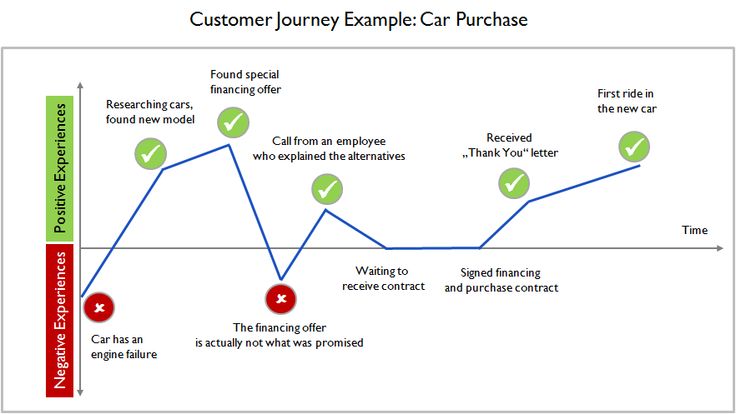
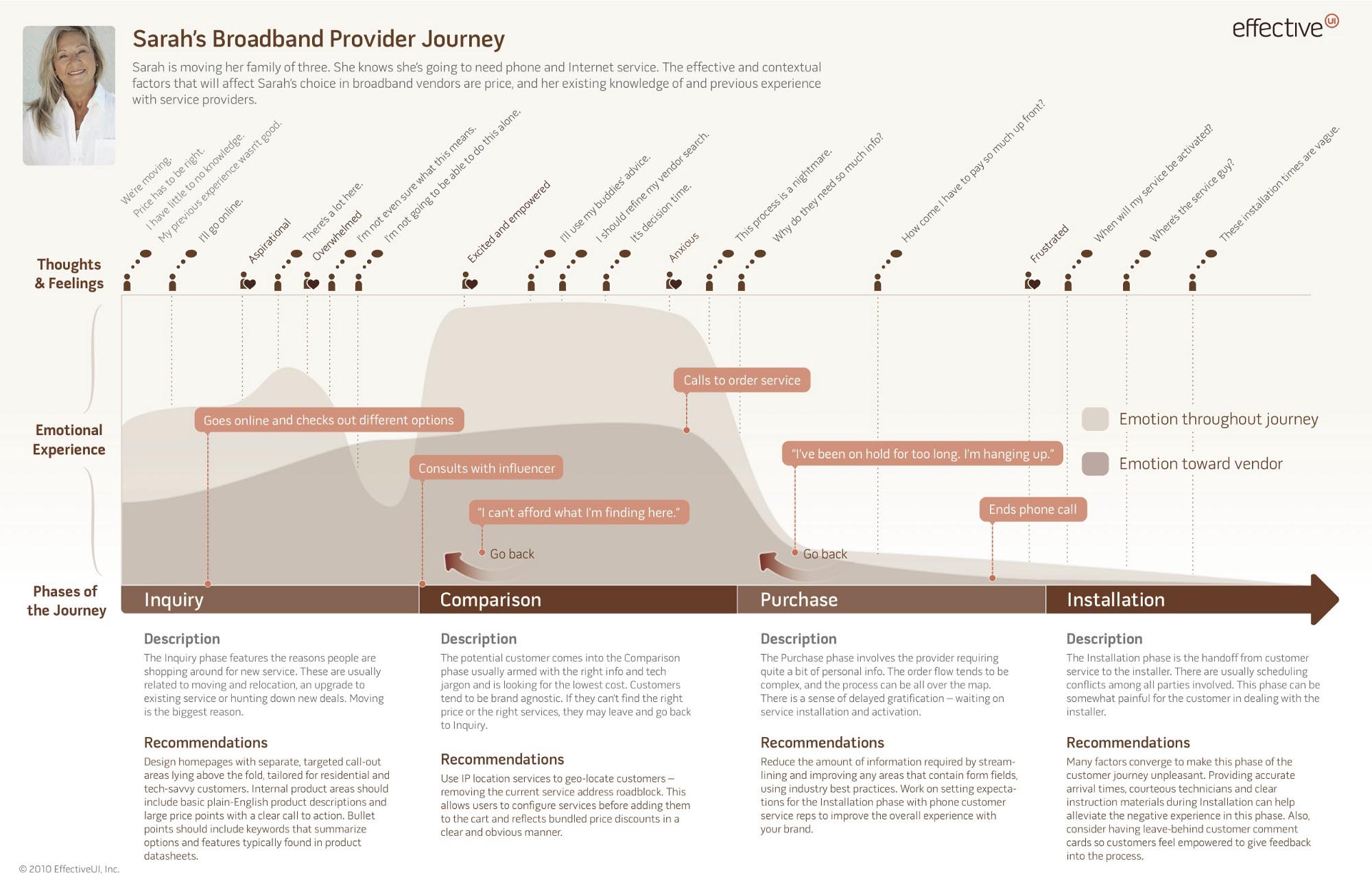
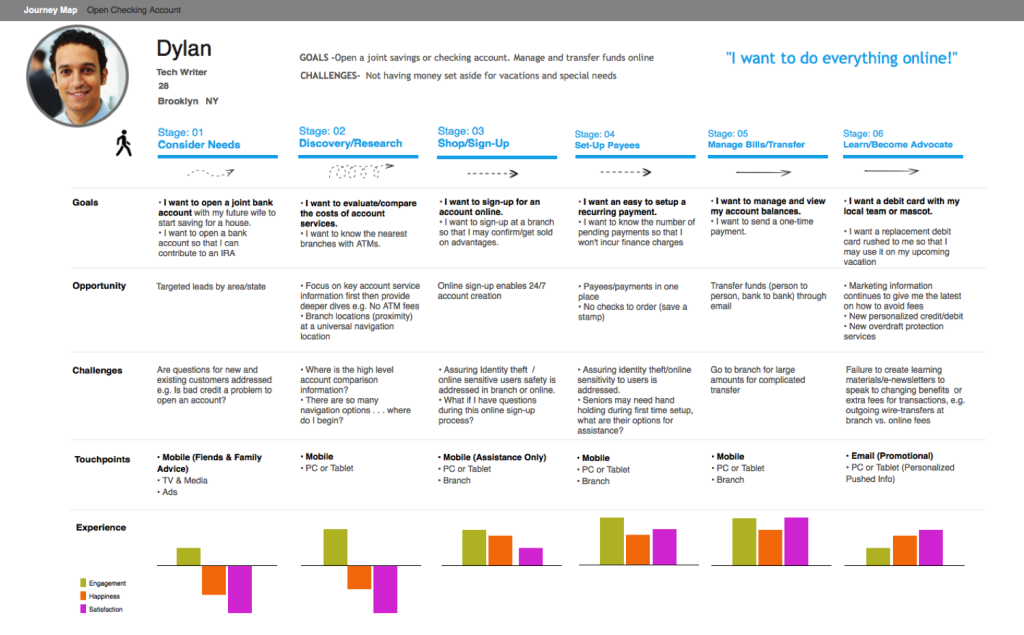

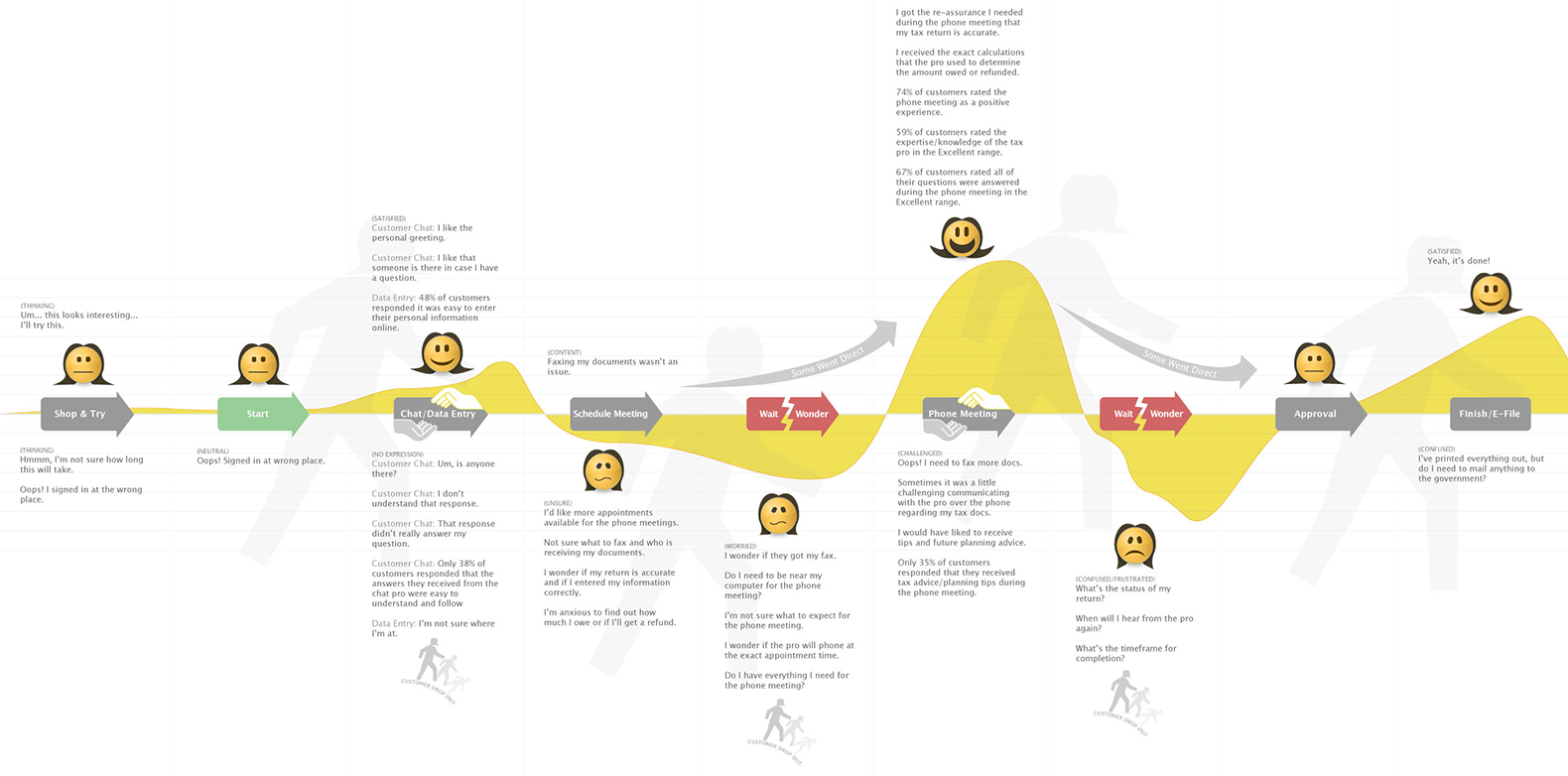
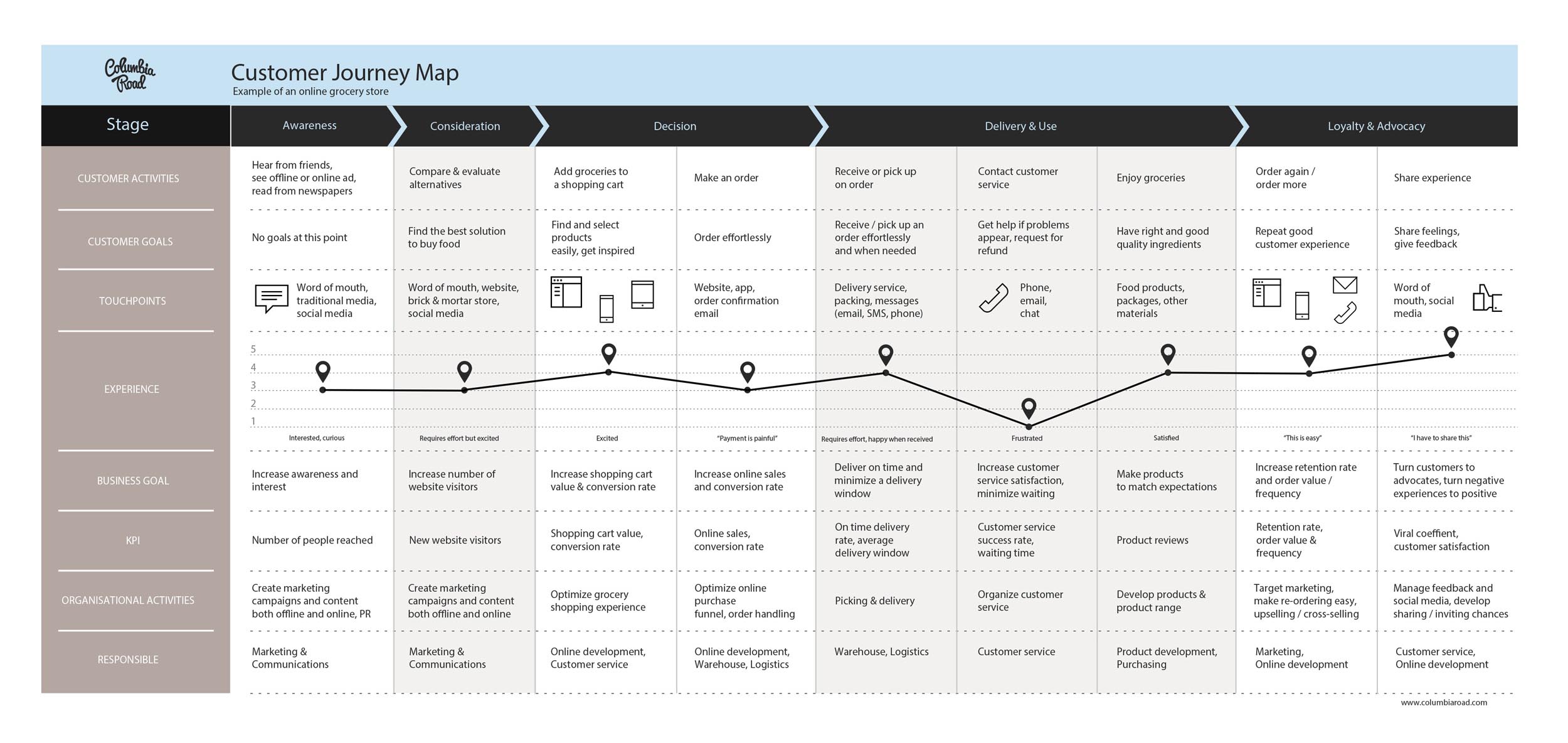
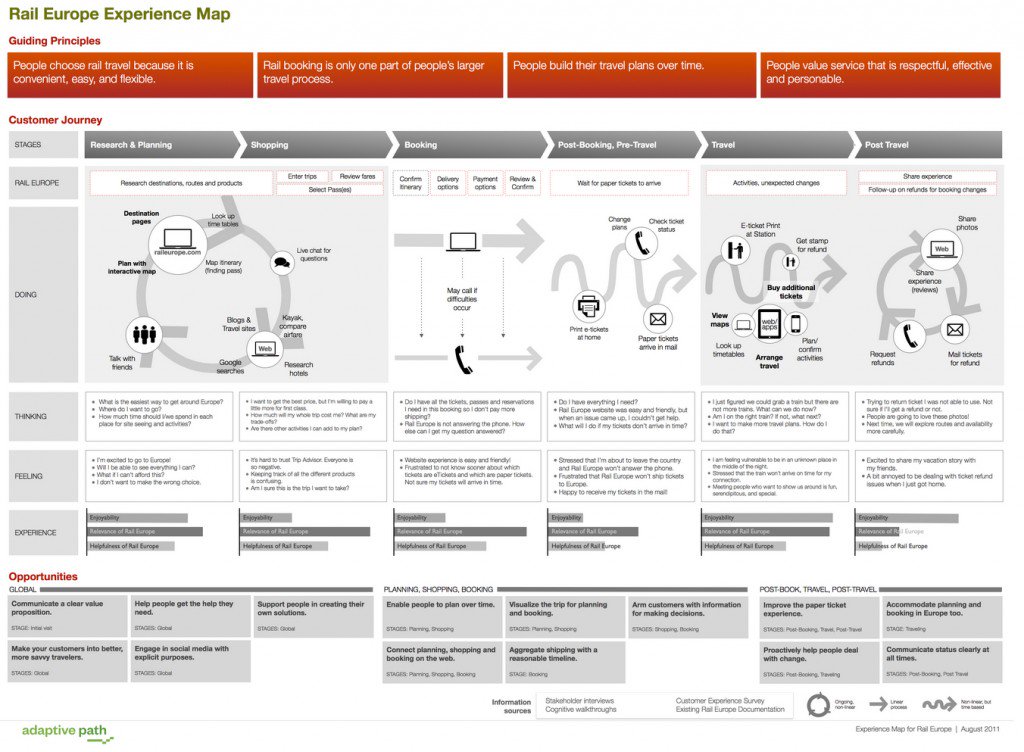
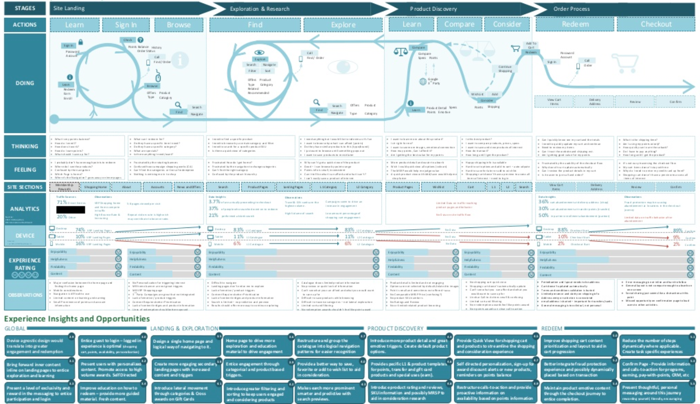
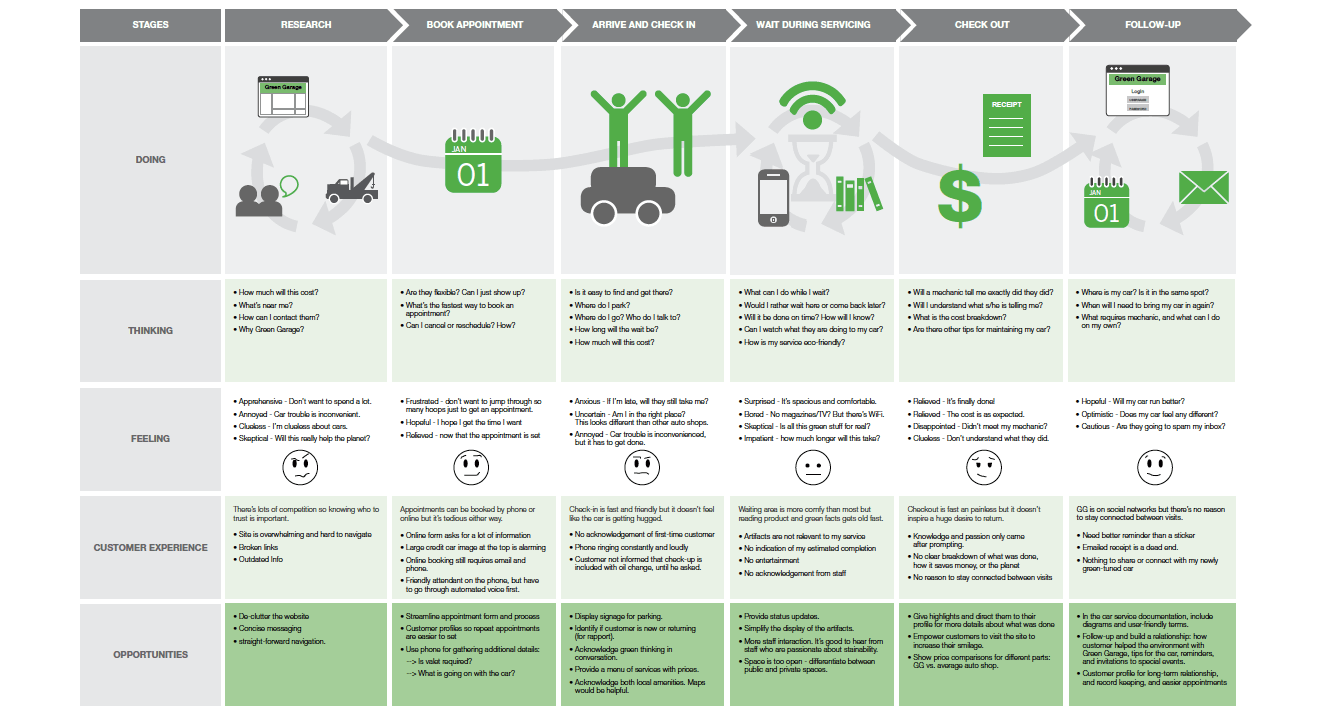
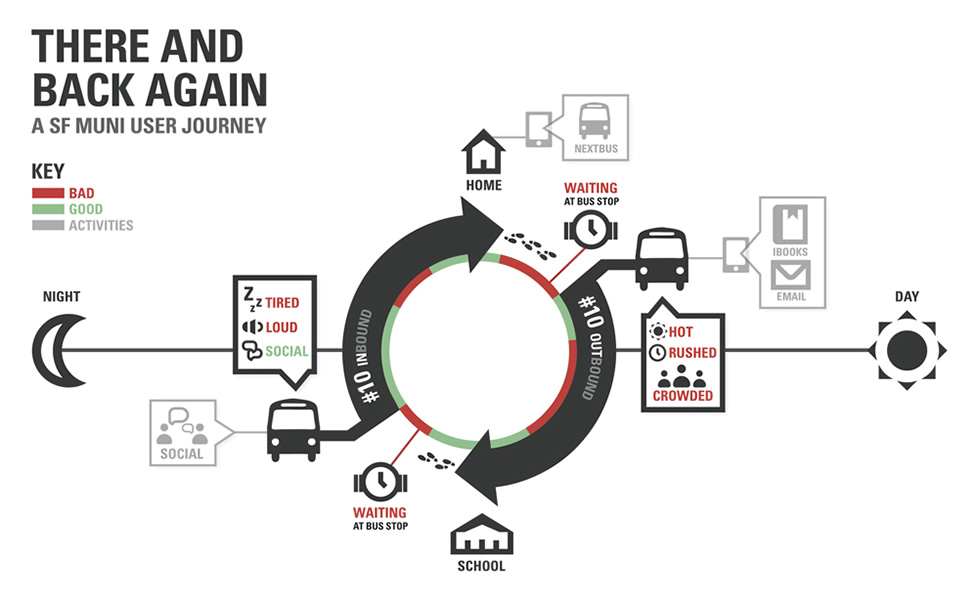

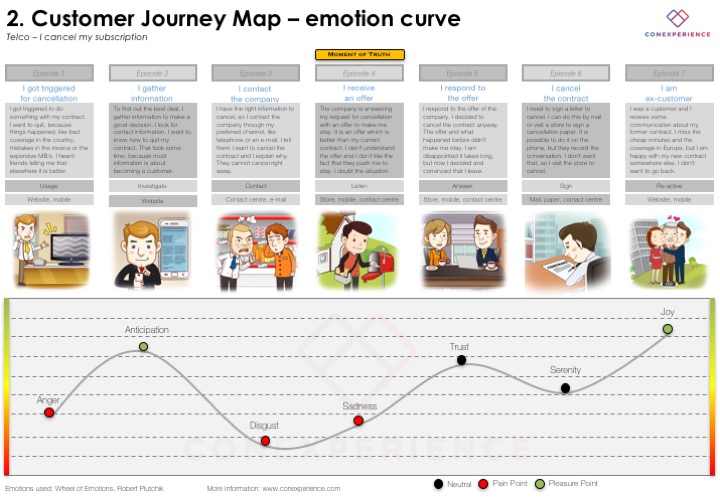

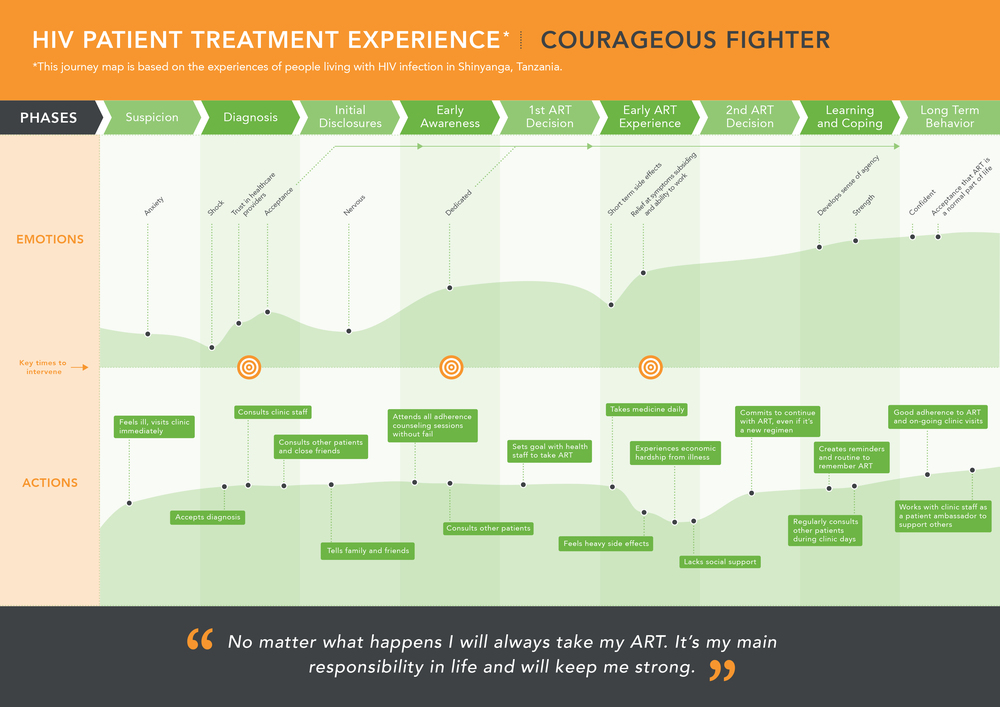
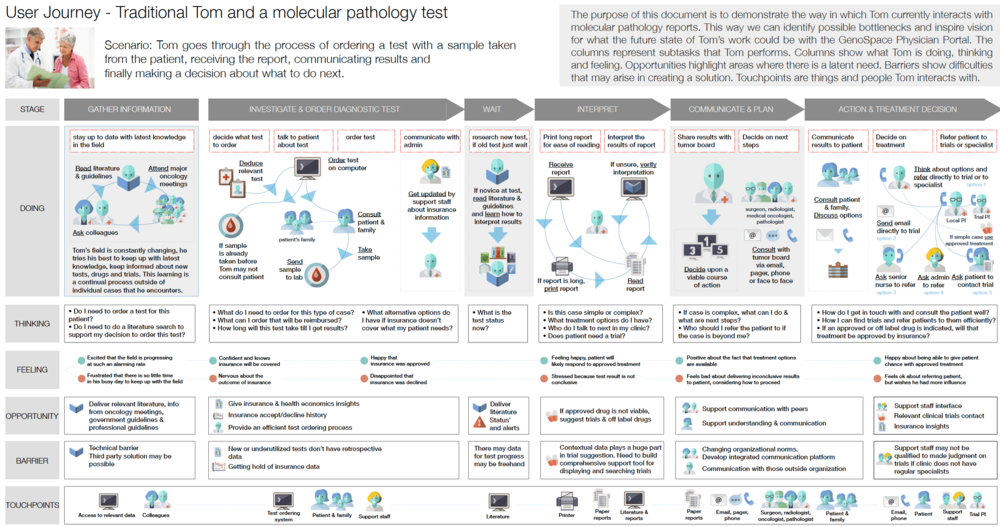




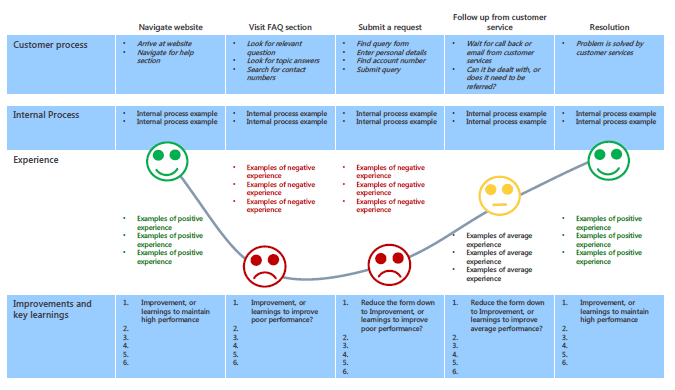

Examples
Airbnb
Airbnb used customer journey mapping to identify areas where their hosts and guests experienced pain points in their booking process. By identifying these areas, Airbnb was able to improve the user experience by making changes to their website and mobile app.
Starbucks
Starbucks used customer journey mapping to improve the in-store experience for their customers. They identified areas where customers experienced long wait times and made changes to their ordering process to reduce these wait times. They also made changes to the layout of their stores to improve the flow of traffic and reduce congestion.
Delta Airlines
Delta Airlines used customer journey mapping to identify areas where their customers experienced frustration and stress during their travel experience. They made changes to their website and mobile app to make it easier for customers to book flights and manage their reservations. They also made changes to their airport lounges to improve the customer experience for their frequent flyers.
Intuit
Intuit used customer journey mapping to improve the onboarding process for new users of their software products. They identified areas where new users experienced confusion and frustration and made changes to their product design and documentation to address these issues.
-
What is the purpose of creating a customer journey map?
Hint The purpose of creating a customer journey map is to gain a better understanding of the customer experience and to identify areas for improvement. -
What customer segments are you targeting?
Hint The customer segments that are being targeted depend on the product or service being offered. -
What are the customer touchpoints and how do they interact with the product or service?
Hint Customer touchpoints are the points of contact between the customer and the product or service. These can include online interactions, physical interactions, customer service interactions, and more. -
What are the customer pain points and how can they be addressed?
Hint Customer pain points are areas where the customer experience is not meeting their expectations. These can be addressed by improving the customer experience, providing better customer service, or offering more features or benefits. -
What are the customer goals and how can they be achieved?
Hint Customer goals are the desired outcomes that customers are looking to achieve when interacting with the product or service. These can be addressed by providing clear information, offering helpful resources, or providing incentives. -
What are the customer needs and how can they be met?
Hint Customer needs are the requirements that customers have when interacting with the product or service. These can be met by providing the necessary features, offering helpful customer service, or providing helpful resources. -
What are the customer expectations and how can they be exceeded?
Hint Customer expectations are the expectations that customers have when interacting with the product or service. These can be exceeded by providing a better customer experience, offering more features or benefits, or providing helpful resources. -
What are the customer motivations and how can they be leveraged?
Hint Customer motivations are the reasons why customers are interacting with the product or service. These can be leveraged by providing incentives, offering helpful resources, or providing a better customer experience. -
What are the customer behaviors and how can they be influenced?
Hint Customer behaviors are the actions that customers take when interacting with the product or service. These can be influenced by providing clear information, offering helpful resources, or providing incentives. -
What are the customer feedback and how can it be used to improve the customer journey?
Hint Customer feedback is the feedback that customers provide when interacting with the product or service. This can be used to improve the customer journey by identifying areas for improvement, providing better customer service, or offering more features or benefits.
You might also be interested in reading up on:
- Jeff Gothelf @jeffgothelf
- Jim Tincher @jimtincher
- Kristi Hines @kristihines
- Annette Franz @annettefranz
- Joe Pulizzi @JoePulizzi
- Outside In: The Power of Putting Customers at the Center of Your Business by Harley Manning and Kerry Bodine (2012)
- Mapping Experiences: A Complete Guide to Creating Value through Journeys, Blueprints, and Diagrams by James Kalbach (2016)
- Customer Experience 3.0: High-Profit Strategies in the Age of Techno Service by John A. Goodman (2014)
- The Customer Journey: How to Design, Measure, and Improve Customer Experience by Lars F. Nielsen and Michael L. Larsen (2016)
- Service Design: From Insight to Implementation by Andy Polaine, Lavrans Løvlie, and Ben Reason (2013)
- How Customers Think by Gerald Zaltman (2003)
- Customer experience by Wikipedia
- A Complete List Of UX Deliverables by Nick Babich
- All You Need To Know About Customer Journey Mapping by Paul Boag
- How To Create A Customer Journey Map by UX Mastery
- How to Create a Customer Journey Map by Megan Grocki
- Journey Mapping is Key to Gaining Empathy by Tiffany Eaton
- Journey Mapping: What, How and When to use Journey Maps by Monica Ray Scott
